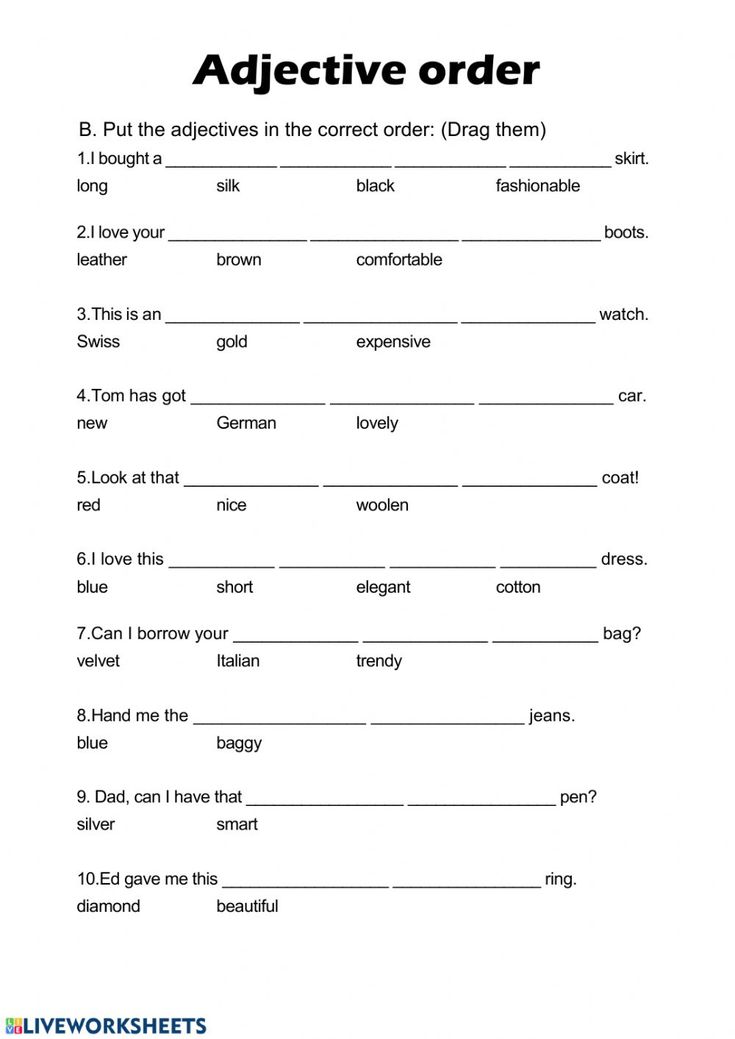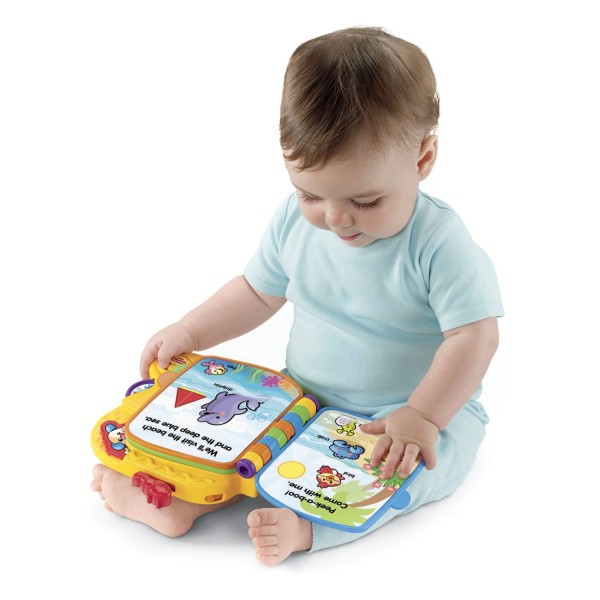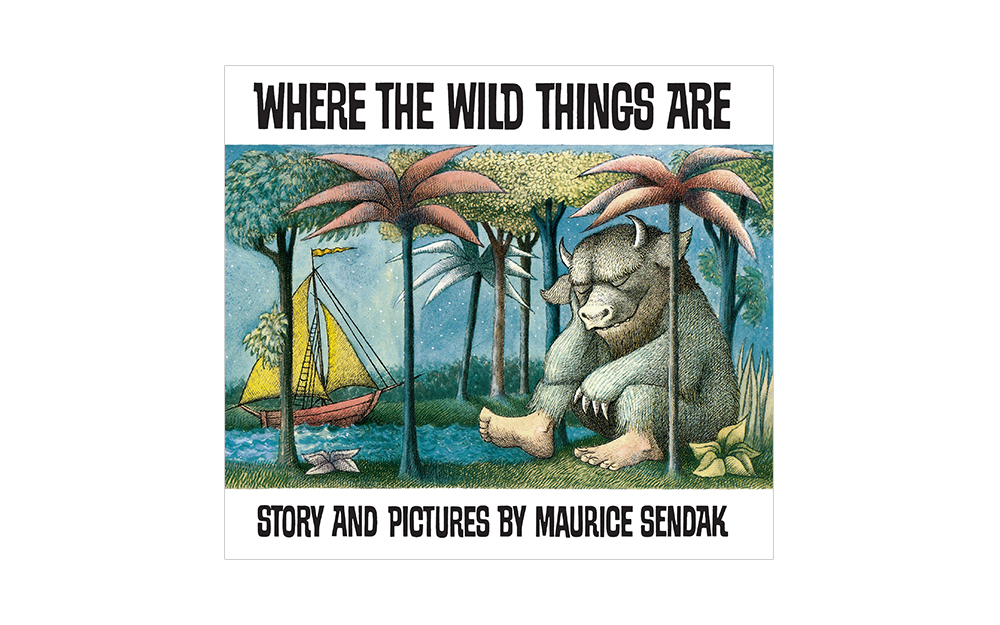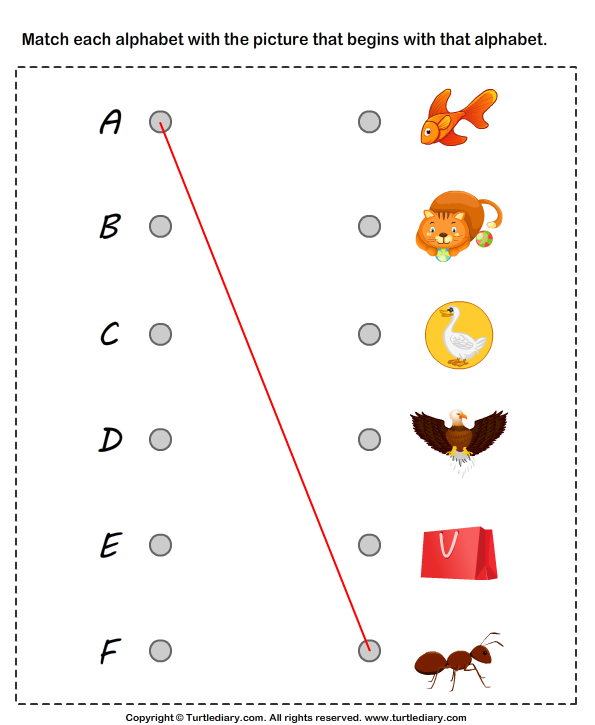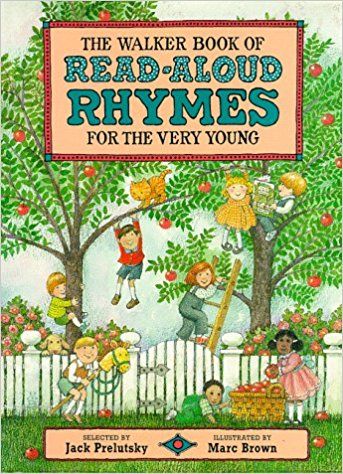What does the stegosaurus eat
Description, Habitat, Image, Diet, and Interesting Facts
The Stegosaurus is another famous dinosaur species that has captivated our imagination. Much of their notoriety comes from their odd, and intriguing, appearance.
The name Stegosaurus roughly translates to “roof lizard,” which only makes sense if you know what they look like! These dinosaurs had large flattened plates along the ridges of their backs. Read on to learn about the stegosaurus.
Description of the Stegosaurus
There were three different species of Stegosaurus, but all were relatively similar looking. Overall, these creatures were short, stout, and powerfully built. They walked on four short legs, had small heads, and long tails capped with defensive spines.
A line of flattened, plate-like spines ran down their backs. The largest species could grow nearly 30 ft. long and weigh up to 7 metric tons.
Interesting Facts About the Stegosaurus
Though they were large by our standards, the other dinosaurs that roamed while Stegosaurus was alive dwarfed it. Simply put, 150 million years ago, some incredibly large creatures walked the earth. Learn how Stegosaurus survived below.
- Plate Debate – Scientists still aren’t quite sure what the large plates along the back of this dinosaur were actually used Though some believe the plates functioned as armor, many debate this, as the plates leave the sides of the animal unprotected. Other theories include making the animal look bigger, sexual displays, and thermoregulation.
- Thagomizer – These creatures weren’t without defenses. At the end of their tail they had four pointed spikes. Stegosaurus’ tail was extremely muscular, and they could forcibly swing these tail spikes into potential predators.
- Cheeky Chewer– Stegosaurus was one of the very first creatures to develop primitive cheeks. The development of cheeks allowed creatures to thoroughly chew their food before swallowing. This gave them the ability to eat more vegetation than other herbivores at the time, because the food was pre-digested when it hit the stomach.

- Butt Brain – These dinosaurs did not have the largest brains. In fact, they had one of the smallest brains of all dinosaurs in comparison to their body size. At one point, this actually led scientists to speculate that they might have additional brain matter in an area near their hips. Basically, they theorized that Stegosaurus had a brain near its butt. While this is possible, it is highly unlikely.
Habitat of the Stegosaurus
Fossils of this dinosaur are actually relatively rare, and because of this we can only speculate the other habitats this creature lived in. Archaeologists found the most specimens in the Morrison Formation, which we have decent information about the ecosystem of during that time.
We know they lived in areas that were semiarid, with a wet season and a dry season. There were flat floodplains, savannas dominated by ferns and the occasional tree, and forests.
Distribution of the Stegosaurus
Determining the extent of this creature’s range is difficult to do, because their fossils are somewhat rare. Researchers found many North American specimens in Colorado, Utah, and Wyoming. They found other fossils in Europe, China, Africa, and India. This suggests that the different Stegosaurus species were relatively widespread.
Researchers found many North American specimens in Colorado, Utah, and Wyoming. They found other fossils in Europe, China, Africa, and India. This suggests that the different Stegosaurus species were relatively widespread.
Diet of the Stegosaurus
We know that this dinosaur was herbivorous based upon its teeth. However, it has some pretty oddly shaped teeth and jaws. Scientists aren’t exactly sure how they chewed and foraged for food, because their mouth is simply, weird.
They do estimate that they fed on a number of different plant types, including ferns, moss, fruits, cycads, conifers, and horsetails. Grasses did not evolve until much later, so these dinosaurs would never have grazed on grasses.
Stegosaurus and Human Interaction
Stegosaurus went extinct around 150 million years ago, and never lived while humans were on earth. The only interactions between Stegosaurus and humans are in movies and television. These are, of course, digital or animatronic dinosaurs.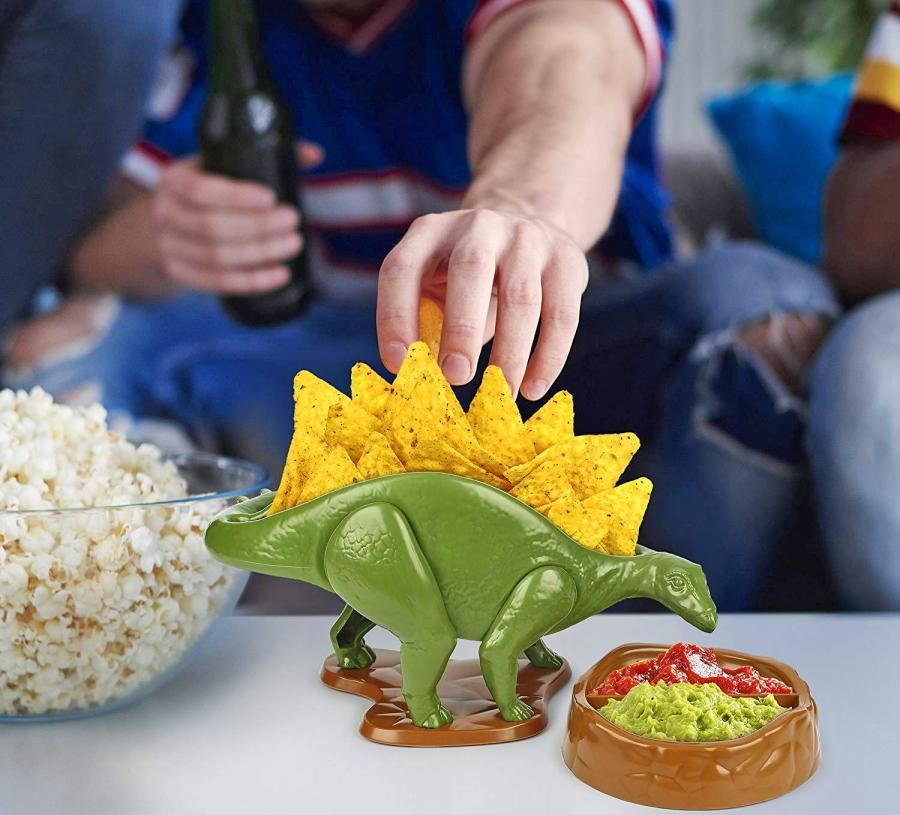
Domestication
Humans never domesticated Stegosaurus in any way, and never interacted with these extinct creatures.
Does the Stegosaurus Make a Good Pet
Even if they were alive, Stegosaurus would not make a good pet. They are somewhat small for dinosaurs, but they are definitely way too big to live in your house! It would be blatantly impossible to own one as a pet, even in theory.
Stegosaurus Care
In a zoological setting, these creatures would probably require care similar to rhinos or elephants. They are powerful animals, and would need strongly reinforced fencing for their enclosures.
Browsing on a wide variety of plants would be essential. Because they had very small brains, reliance on environmental enrichment would be much less pressing than in hyper-intelligent species like elephants.
Behavior of the Stegosaurus
Unfortunately, fossils do not provide much insight into the behavior of an animal. We can use rock formations to determine habitat, and damaged fossils to speculate interactions between animals, but beyond that all behavior is speculative.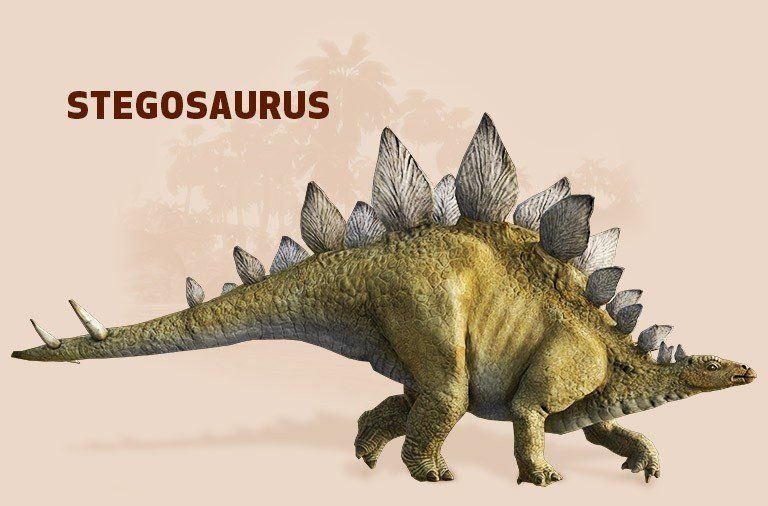
These creatures were large, and had incredibly small brains. It is likely that their life consisted pretty much of slowly searching for food, and defending themselves from predators.
Reproduction of the Stegosaurus
We know very little about the reproduction of these dinosaurs. Scientists believe they reproduced sexually, via mating, and laid eggs. Some theories suggest that the large plates on their back could change color as a mating display or to attract a female. As to the number of eggs, incubation time, and parental care, we simply don’t know yet.
Dinosaur eating habit insights from Stegosaurus stenops
NEWS
By Katie Pavid
First published 20 May 2016
New tests carried out on the Museum's Stegosaurus skull provide ground-breaking insights into the lifestyles of herbivorous dinosaurs.
CT scans of the Stegosaurus stenops specimen have helped researchers piece together the eating habits of different herbivores.
The specimen - the most complete stegosaur in the world - was acquired by the Museum in 2014.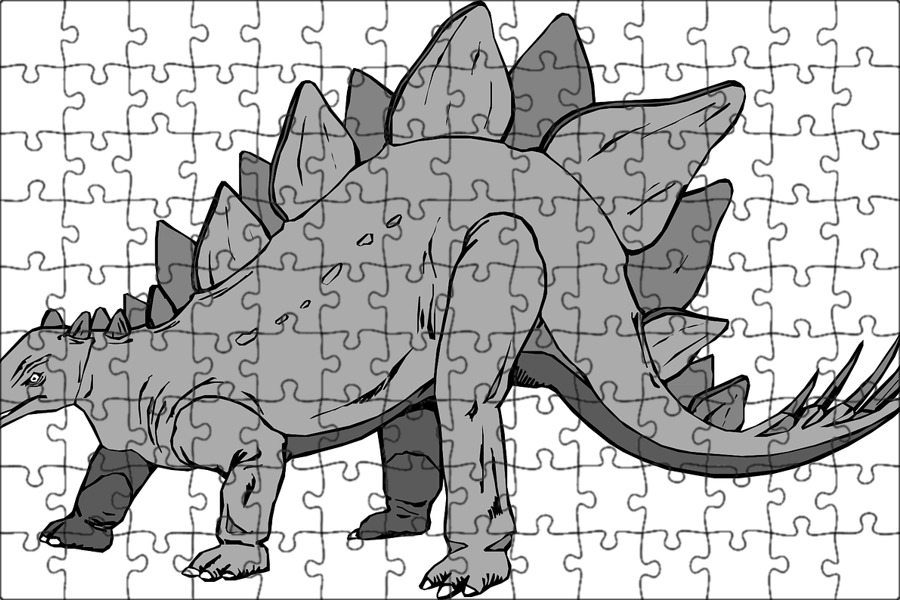
New research, published in Scientific Reports, compares the dinosaur's skull to those of Plateosaurus and Erlikosaurus.
The skulls of the three dinosaurs look remarkably similar, but scientists found that each one ate in a very different way.
Professor Paul Barrett, a Museum palaeobiologist who leads the research team working on the Stegosaurus, says:
'Our key finding really surprised us. We expected that many of these dinosaur herbivores would have skulls that worked in broadly similar ways.
'Instead, we found that even though the skulls were fairly similar to each other in overall shape, the way they worked during biting was substantially different in each case.
'This information allows us to understand more about their different feeding specialisms.'
Plant eaters
Several groups of dinosaurs developed plant-based diets independently of each other, despite being unrelated and having very different body shapes. Some walked on all fours, others on their hind limbs only, and others developed long necks.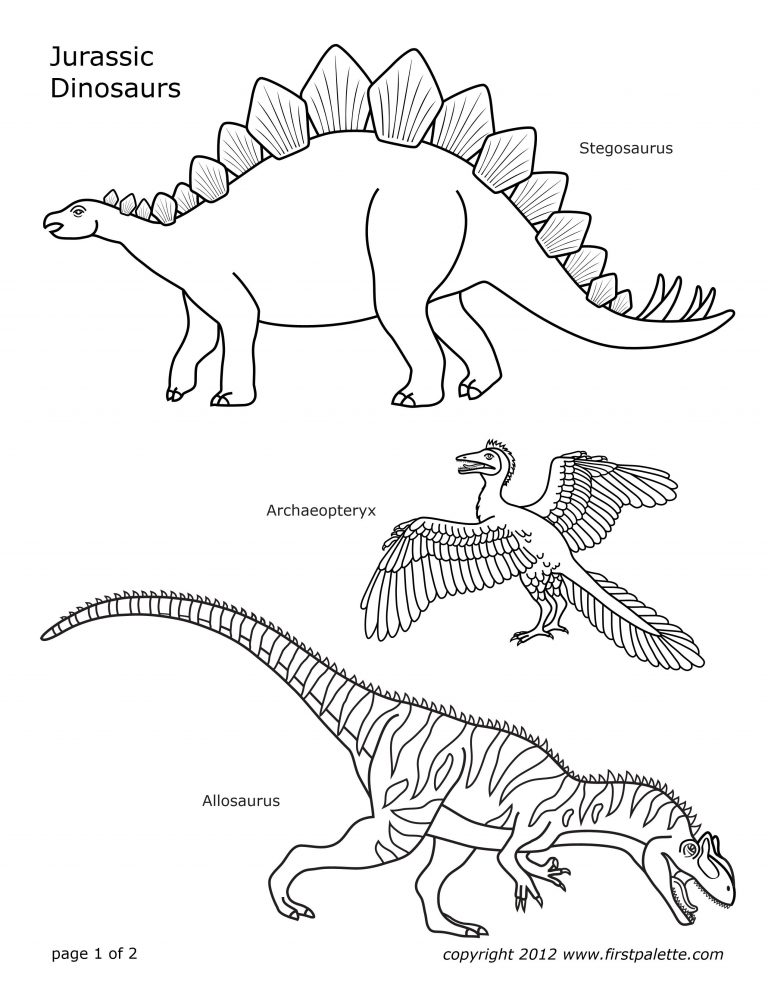
The Stegosaurus skeleton on display in the Museum's Earth Hall is the most complete in the world
However, many of these herbivores had long, narrow skulls, scissor-like jaw actions and similar arrangements of teeth.
The study investigated the skulls of specimens from three groups - sauropodomorphs, theropods, and ornithischians. The Museum's Stegosaurus stenops specimen represented the ornithischians.
Barrett says, 'Although Stegosaurus has been known about for more than 130 years, not much is known about its biology.
'Because the Museum's skeleton is almost complete - and three-dimensional - we can do a lot of things that have not been possible until now.
'The bones in our specimen's skull are separated from each other, so we can see how the skull fits together in 3D. We can then use this information to see how the skull would work as a chewing machine.'
A powerful bite
Digital models were made of the skulls and lower jaws, using CT scans of the original specimens.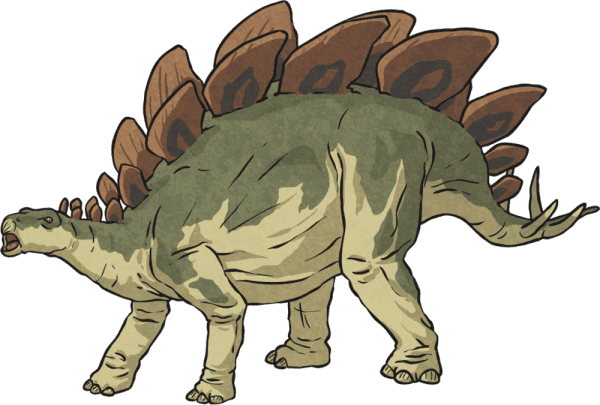
The results show that, despite their similar skulls and teeth, the biomechanical behaviours of the dinosaurs are notably different.
A digital model of the skull of Stegosaurus stenops, showing which areas experience stress during eating. Yellow and red show high stress areas, and blues and greens show areas of low stress. © Stephan Lautenschlager, University of Bristol.
Their biomechanics probably reflect dietary specialisations and differing feeding habits.
In turn, these distinct feeding habits might reflect the vegetation available in their local environment.
Researchers found that Stegosaurus had a particularly powerful bite for a herbivorous dinosaur.
Barrett said, 'The high bite force of Stegosaurus was another surprise. It was much stronger than previously suspected.
'We found that far from being feeble, Stegosaurus actually had a bite force within the range of living herbivorous mammals, such as sheep and cows.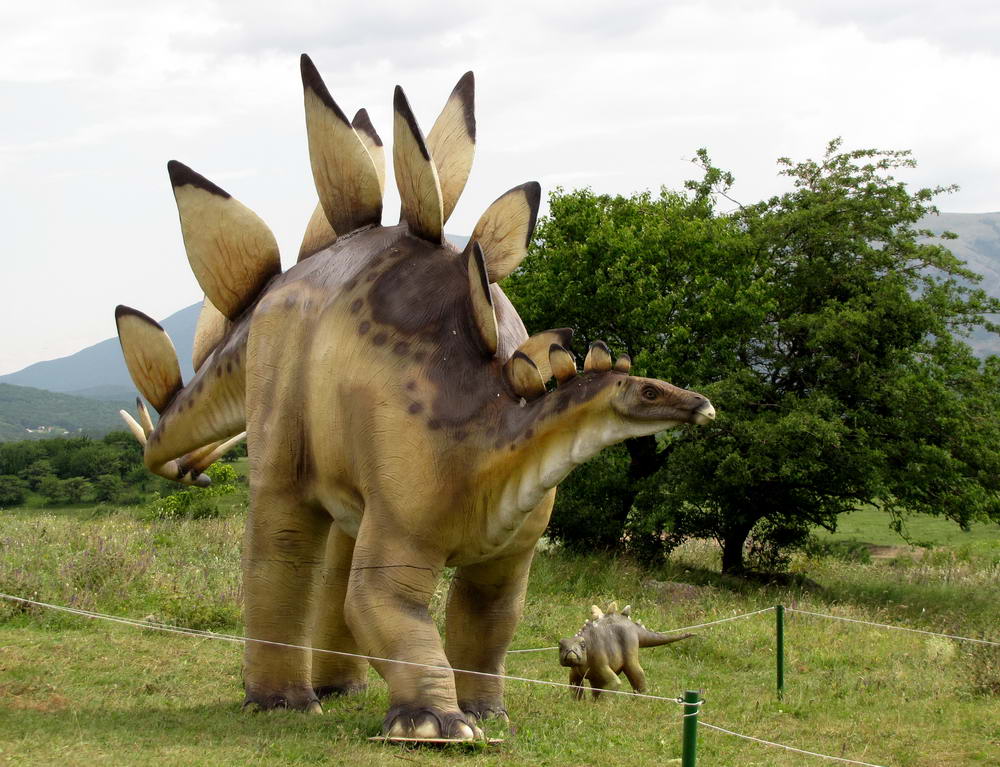 '
'
More on the menu
The shape of the Stegosaurus skull allowed for more jaw muscle mass than the other herbivores. This meant a more efficient conversion of muscle strength into the force of the bite.
The research shows that Stegosaurus would have been capable of foraging on a wide variety of plants, including ferns and cycads.
It probably had access to a wider range of potential food sources than Plateosaurus, which would have relied on more tender vegetation.
Erlikosaurus had a skull that was specialised to exploit its beak-like tip.
Barrett said, 'It is very tempting to assume that because the skulls of these dinosaurs were very similar, their feeding habits were also the same. But our data indicate this was not the case.
'These computer-based methods give us detailed insights into dinosaur biology that were not previously possible, and this represents the first ever detailed study of feeding in Stegosaurus. '
'
- Science news
- Fossils
- Prehistoric
- Stegosaurs
Dinosaur Stegosaurus. Report, message, photo, video
Stegosaurus belonged to the family of dinosaurs, which along the spine, from neck to tail, had a double row of bone plates. For the purpose of defense, he used his tail, which had sharp spikes at the end. Report-message with video and photo
Order - Ornithischians
Family - Stegosaurus 900 9009 Species Genus
11 Stegosaurus stenops. Stegosaurus
Basic data:
DIMENSIONSLength: up to 9 m.
Weight: 6-8 tons.
Head length: about 45 cm.
The size of the brain: 3 cm.
Spinal plates: up to 60 cm high.
tail spikes: length 1 m. 9000
Mating period: time unknown; perhaps there were fights between males for the right to fertilize the female.
Laying time: probably several times a year.
LIFESTYLE
Habitat: Tropical.
Food: vegetation.
Habits: Stegosaurus (see picture) probably led a herd life.
RELATED SPECIES
A five meter long Kentrosaurus that lived in Africa.
The Stegosaurus dinosaur lived about 170 million years ago. Despite the intimidating appearance, he was a peaceful herbivore. It is likely that he lived in herds. They gave him security more by their numbers than by the militancy of the members of the herd.
FOOD
Stegosaurus was a herbivore and fed on many kinds of plants. In that historical period, a tropical climate prevailed on Earth in America, the earth was covered with lush vegetation.
In that historical period, a tropical climate prevailed on Earth in America, the earth was covered with lush vegetation.
Examination of Stegosaurus fossil skeletons has shown that Stegosaurus had fairly strong dorsal muscles associated with outgrowths on the hips at the base of the tail. These muscles apparently allowed the Stegosaurus to stand up on its hind legs, thanks to which it reached plants that grew high. It is interesting to know that his body was not specially adapted to plant foods - his teeth were small and weak. It is believed that he, like other dinosaurs and modern crocodiles, swallowed stones to grind plant fibers.
REPRODUCTION
One of the reasons why dinosaurs are so exciting is that very little is known about them. Therefore, you can always make some kind of discovery, and the finds can be hidden in the ground right under our feet.
Dinosaurs, including Stegosaurus, have been known to lay several relatively small eggs in shallow holes dug in the ground.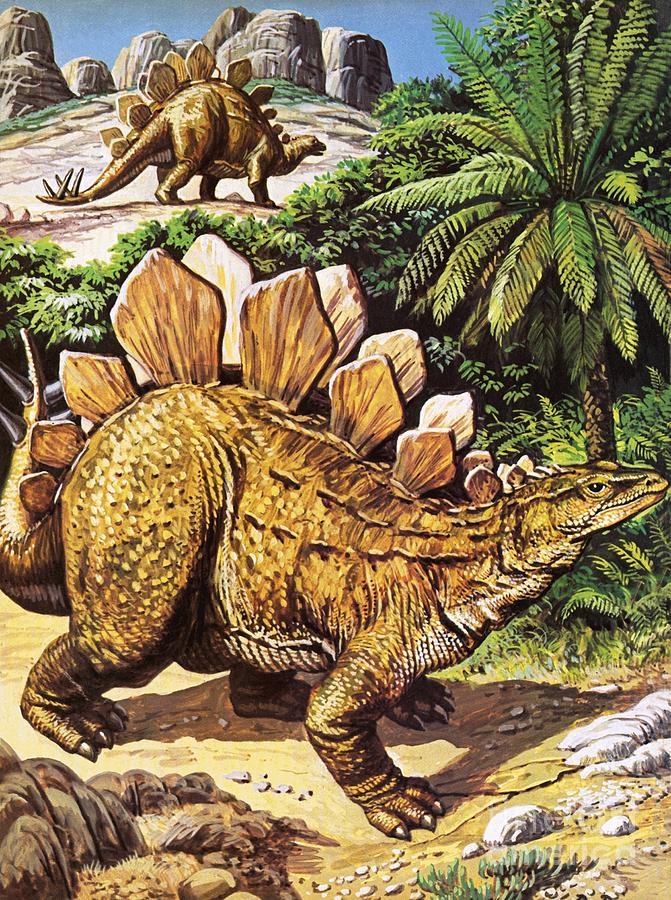 They covered the eggs with sand so that the sun's rays warmed them. Newborn cubs grew very quickly, thereby avoiding the fate of becoming easy prey for predators.
They covered the eggs with sand so that the sun's rays warmed them. Newborn cubs grew very quickly, thereby avoiding the fate of becoming easy prey for predators.
During the defense against attackers, the cubs were placed in the center of the herd. Since the Stegosaurus was a herd animal, the males competed for the right to possess the female and be the leader of the herd. In such situations, herbivores only make threatening sounds and demonstrate their strength to other males, but do not enter into an open fight.
ENEMIES
The peaceful Stegosaurus was often the victim of carnivorous dinosaurs, such as the dangerous Tyrannosaurus Rex.
Stegosaurus was most likely rather slow and defenseless, especially when attacked from the side and in the leg area. He was slow and therefore could not run away from predators. He defended himself by unexpectedly hitting the attacker with his tail, which was covered with spikes. Each of the spikes on the tail was about 1 m long.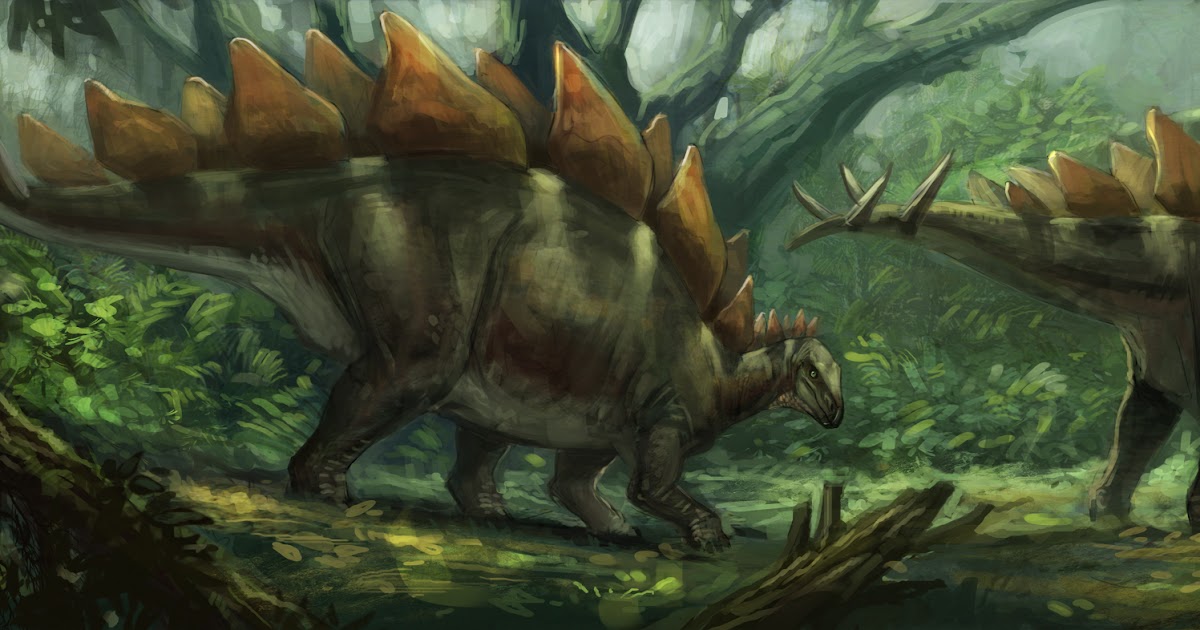 Stegosaurus had two pairs of them.
Stegosaurus had two pairs of them.
Some species related to Stegosaurus had four pairs of spines. The spikes were quite keratinized and could seriously injure the enemy if he fell into their reach.
SPECIAL SIGNS. DESCRIPTION
Stegosaurus belongs to the dinosaurs that have a double row of bony plates along the spine on the back.
There are many theories that try to explain the purpose of the plates, the highest of which is 60 cm high. Some claim that the plates were needed for self-defense. According to other theories, they served to regulate the temperature.
If the plates were covered with skin with many blood vessels, then, being turned towards the sun, they could serve the animal for heating the body, and when placed in the shade, they cooled the body.
Stegosaurus had four spikes at the end of its tail, which it apparently used to protect itself.
Stegosaurus did not belong to the largest dinosaurs, however, its body length reached 9 meters.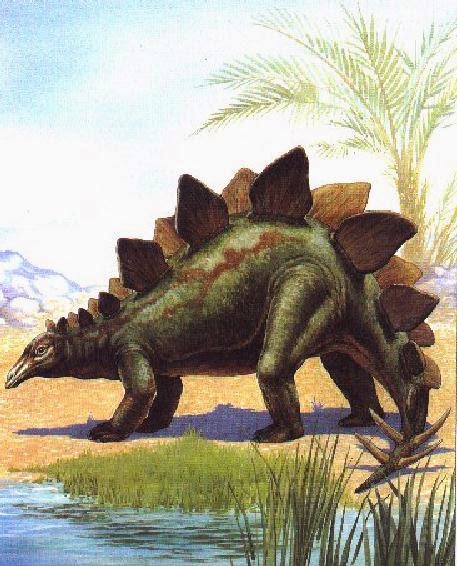 The forelimbs were half as long as the hind ones, so the stegosaurus moved by leaning forward strongly.
The forelimbs were half as long as the hind ones, so the stegosaurus moved by leaning forward strongly.
The head of the stegosaurus was very small, about 45 centimeters long, and almost touched the ground. Its brain was also small - only about 3 cm.
At that time, a warm, almost tropical climate prevailed there - ideal for such herbivorous dinosaurs as the Stegosaurus. The vegetation that grew on the continent, at first glance, resembled a modern rainforest, but today's plant species did not exist at that time. So, there were no flower plants. Everywhere, next to ferns and coniferous trees, ancient palm trees grew, which, in their appearance, resembled modern ones.
INTERESTING INFO. DID YOU KNOW THAT...
- Fossilized remains of a relative of the Stegosaurus have been found in Western Europe.
- Stegosaurs apparently lived for a short time in the Jurassic. The remains of these dinosaurs are found only in the upper layers of rocks.

- Some modern reptiles look like smaller versions of extinct dinosaurs.
- A lizard that lives in Africa has spikes on its head and body similar to those on a Stegosaurus. However, this lizard is 60 times smaller than a Stegosaurus, and its length reaches only 60 cm.
STEGOSAUR FEATURES
Dorsal plates: ran from head to tip of tail. There are many theories that explain their purpose, including one that suggests that they served to regulate body temperature.
Head: small compared to large body. The brain is the size of a walnut.
Forelegs: much shorter than the hind legs, designed for walking.
Hindquarters: strong, able to bear the weight of the entire body of the animal.
WHERE AND WHEN THE STEGOSAUR LIVED
The Stegosaurus Dinosaur lived in the late Jurassic period 170 million years ago in North America. Its fossilized footprints have been found in Colorado, Oklahoma, Utah, and Wyoming. It is not uncommon for Stegosaurus footprints to be found in large numbers and extend for many kilometers. Other members of the Stegosaurus family lived in places like Western Europe, East Asia, and East Africa.
Its fossilized footprints have been found in Colorado, Oklahoma, Utah, and Wyoming. It is not uncommon for Stegosaurus footprints to be found in large numbers and extend for many kilometers. Other members of the Stegosaurus family lived in places like Western Europe, East Asia, and East Africa.
Stegosaurus vs Triceratops. Video (00:04:30)
Stegosaurus is a herbivorous dinosaur
- BASIC FACTS
- Time of life and its habitat (period): Jurassic (155-145 million years ago), lived in the western United States (approximately the states of Wyoming and Colorado).
- Found: Colorado 19th century
- Kingdom: Animals
- Era: Mesozoic
- Type: Chordates
- Group: Ornithischian
- Subgroup: Thyreophores
- Class: Reptiles
- Superorder: Dinosaurs
- Infraorder: Stegosaurus
- Family: Stegosaurids
- Genus: Stegosaurus
A unique species of dinosaurs, which is remembered for its unusual body structure.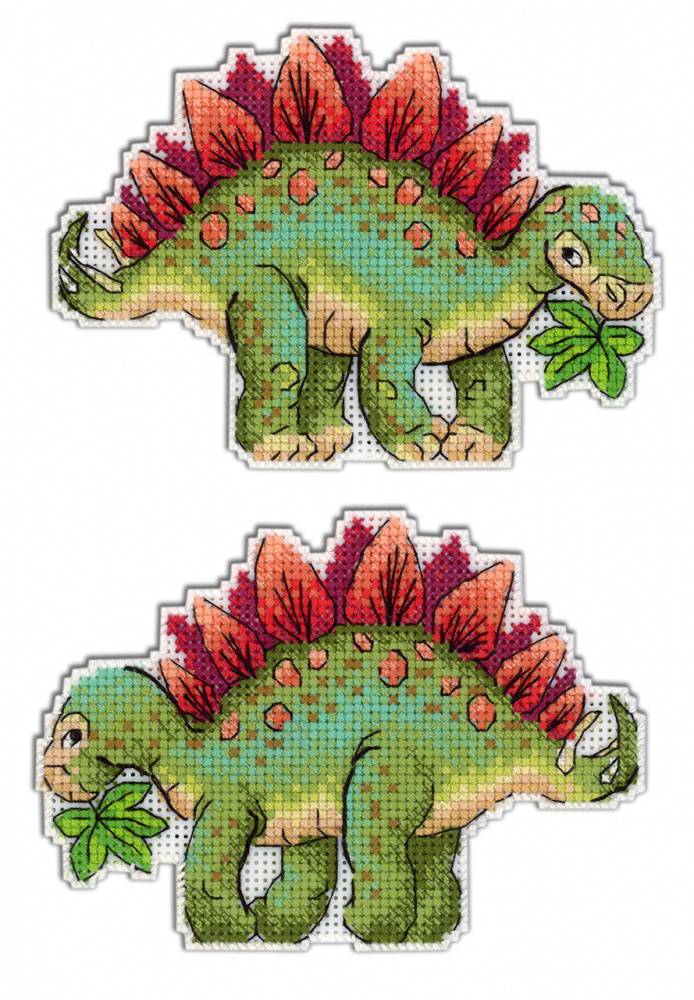 On the back and tail, it has a kind of plate resembling poplar or laurel leaves (depending on the age of the dinosaur).
On the back and tail, it has a kind of plate resembling poplar or laurel leaves (depending on the age of the dinosaur).
These dinosaurs were herbivores, moved on 4 legs, there are spikes and bone plates on the tail and back.
What did they eat and how did they live
Stegosaurs used only vegetation, because. their teeth didn't allow them to chew anything harder. Stegosaurus also swallowed whole stones, which they rubbed leaves in the stomach and helped improve digestion.
Body structure details
This dinosaur had excellent protection, solid bone outgrowths were located throughout the body, perfectly protecting its throat, legs and torso.
Plates of various sizes are arranged in 2 rows on the back, the largest plates grew up to 1m. They were not particularly durable and were used more for intimidation than protection. When an enemy appeared, the plates were painted red (the color of danger), which scared off predators, and also helped to compete for females with other males of this species. In addition, the back plates were a thermostat that accumulated heat and removed its excess.
When an enemy appeared, the plates were painted red (the color of danger), which scared off predators, and also helped to compete for females with other males of this species. In addition, the back plates were a thermostat that accumulated heat and removed its excess.
But there were very sharp spikes on the tail, making a blow with the tail, it could stun its attacker and even kill. The number of such spikes could be up to 4 pieces, and their length was from 70 cm to 1 meter.
Dimensions
It reached a length of 9m (the largest stegosaurus was found in Arizona - 9m 79cm)
The height of the stegosaurus was no more than 4 m
Body weight - 5-7 tons
Stegosaurus head
The head was small, especially considering the enormous body of the dinosaur. The skull did not exceed 40 cm in length.
The brain also did not differ in large sizes - the size of a walnut.

